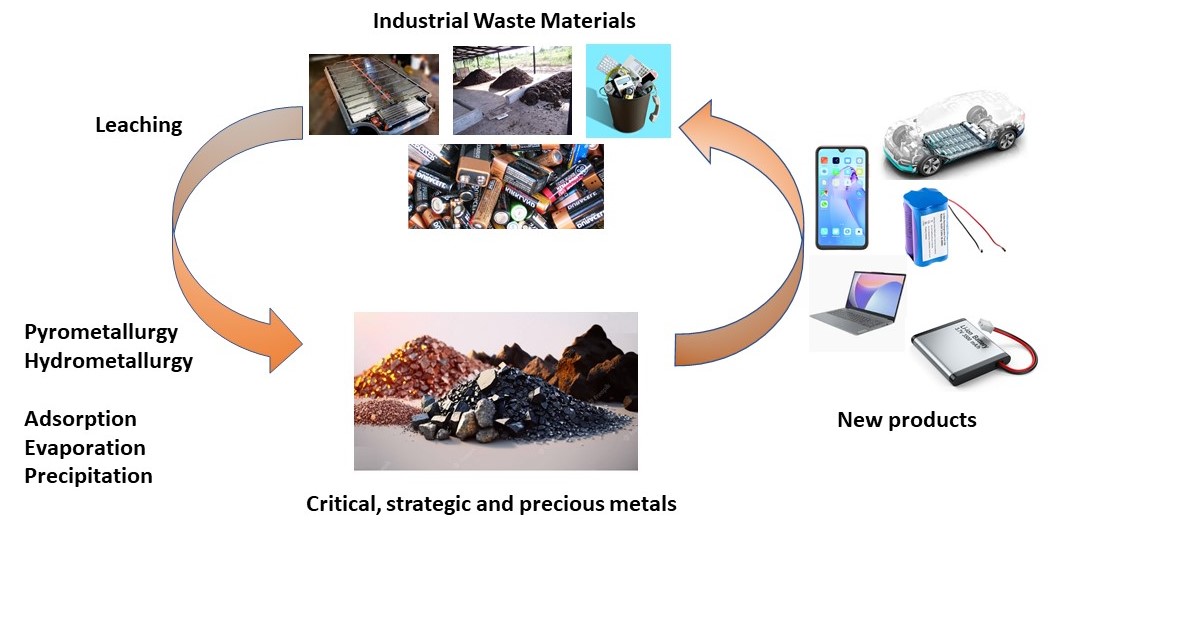Advances in the Recycling of Industrial Waste: Critical Minerals in the Clean Energy Transition
A special issue of Molecules (ISSN 1420-3049). This special issue belongs to the section "Green Chemistry".
Deadline for manuscript submissions: closed (30 September 2025) | Viewed by 7422

Special Issue Editors
Interests: recycling; extraction of critical metals; hydrometallurgy; metal; waste management; urban mining
Special Issues, Collections and Topics in MDPI journals
Interests: recycling; waste; hydrometallurgy; circular economy; mining waste; battery waste; metals; rare earth
Special Issues, Collections and Topics in MDPI journals
Special Issue Information
Dear Colleagues,
The Earth is overheating. Scientists agree that anthropogenic emissions of greenhouse gases into the atmosphere are to blame for this change. The United Nations Climate Change Conference in Glasgow (COP26) ratified the commitment to achieve so-called Carbon Neutrality by 2050. To achieve this goal, energy transition is essential. Changing from an energy system based on the use of fossil fuels to a low-emission or carbon-free one, based on intensive use of materials in which the supply of mineral raw materials, many of which are critical, is crucial. COP28 in Dubai agreed to the transition away from fossil fuels. Clean energy technologies require more mineral resources than those based on fossil fuels. According to estimates by the International Energy Agency (IEA), current mineral consumption is set to quadruple and, in the case of a zero-emissions scenario in 2050, it could increase sixfold, raising huge questions about the availability and reliability of mineral resource supply. Even if there are sufficient mineral resources, it is not guaranteed that supplies will be easily and affordably available where and when they are needed. The two main parameters for determining criticality have been economic importance and supply risk for the EU. Critical raw materials (CRM) are key materials for renewable energy technologies and electric mobility. Given the decline in scarce but essential raw materials such as indium, tin, lithium, cobalt, magnesium, tantalum, antimony, rare earths, gold, silver, copper, etc. and their difficulty in obtaining them, the proposal for recycling and recovering critical metals has recently emerged, which seems to be one of the strategies to help lighten mineral extraction; however, to date most of these resources have low recycling and/or recovery rates at the end of their useful life. For example, in the case of batteries, some authors point out that recycling them has the greatest opportunity to reduce primary demand for metals such as cobalt, lithium, nickel and manganese. This Special Issue aims to consolidate advances in industrial waste recycling, focusing especially on the separation and recovery of critical and strategic metals from post-consumer products, mining waste or minerals (using chemical methods: pyrometallurgical, hydrometallurgical, adsorption, evaporation, precipitation techniques, etc.). Articles and reviews dealing with the development of any cited recycling technology, and any innovative technologies that could be used for composites, as well as their exploitation, are very welcome. We look forward to receiving articles addressing the development of any recycling technology with/using chemical methods (pyro and hydrometallurgical processes with novel and different extraction agents) that could be used for separation of metals in critical and critical and strategic in raw materials, innovate applications and sustainability studies, and other relevant topics.
Dr. María Isabel Martín Hernández
Dr. Olga Rodríguez Largo
Guest Editors
Manuscript Submission Information
Manuscripts should be submitted online at www.mdpi.com by registering and logging in to this website. Once you are registered, click here to go to the submission form. Manuscripts can be submitted until the deadline. All submissions that pass pre-check are peer-reviewed. Accepted papers will be published continuously in the journal (as soon as accepted) and will be listed together on the special issue website. Research articles, review articles as well as short communications are invited. For planned papers, a title and short abstract (about 250 words) can be sent to the Editorial Office for assessment.
Submitted manuscripts should not have been published previously, nor be under consideration for publication elsewhere (except conference proceedings papers). All manuscripts are thoroughly refereed through a single-blind peer-review process. A guide for authors and other relevant information for submission of manuscripts is available on the Instructions for Authors page. Molecules is an international peer-reviewed open access semimonthly journal published by MDPI.
Please visit the Instructions for Authors page before submitting a manuscript. The Article Processing Charge (APC) for publication in this open access journal is 2700 CHF (Swiss Francs). Submitted papers should be well formatted and use good English. Authors may use MDPI's English editing service prior to publication or during author revisions.
Keywords
- waste material recycling
- metal removal
- metal recovery
- critical metal separation
- hydrometallurgical processes
- pyrometallurgical process
- urban mining
Benefits of Publishing in a Special Issue
- Ease of navigation: Grouping papers by topic helps scholars navigate broad scope journals more efficiently.
- Greater discoverability: Special Issues support the reach and impact of scientific research. Articles in Special Issues are more discoverable and cited more frequently.
- Expansion of research network: Special Issues facilitate connections among authors, fostering scientific collaborations.
- External promotion: Articles in Special Issues are often promoted through the journal's social media, increasing their visibility.
- Reprint: MDPI Books provides the opportunity to republish successful Special Issues in book format, both online and in print.
Further information on MDPI's Special Issue policies can be found here.







